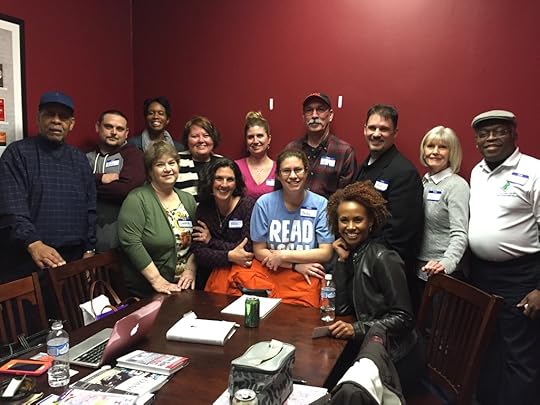Becky Robinson's Blog, page 58
April 21, 2016
How to Live a Creative and Inspired Life
This post is a part of our 2016 Team Buzz Builder Guest Blogger Series. Today we are pleased to introduce you to Brandi Walerius, the owner of Black & White Consulting.
The older I get the more I realize there’s one significant thing that gets in the way of making an ordinary life extraordinary. That one thing, when present, can be our biggest critic and fuel that nagging voice inside our minds that creates the dreaded self-doubt. That one thing if you haven’t figured it out, is fear, the paralyzing type.
I used to think I wasn’t creative, but just recently, I realized I’ve been conveniently lying to myself. It’s not that I’m not the creative type, it’s that fear lurks inside of me and sabotages my inspired ideas before I can breathe life into them.
A beauty of getting older though, is the realization that life is short. Instead of being afraid of what others think, I should be more afraid of not fulfilling my full potential by letting fear rule. I need to stop staying ordinary and in my comfort zone because I won’t leave to allow magic to live and for the possibility of extraordinary to exist. Yes, I’m starting to realize I don’t need anyone’s permission to live a creative life, just my own.
I’m so guilty of constantly saying “I would but (fill in the blank).” Fill in the blank with I don’t know how, I don’t know if it will work, what if it fails? It’s easy to feel like underdogs in this big bad world. It’s easier to stay put, to let doubt rule our lives and be used as the basis of decision making. To be the murderer of our dreams.
If you can relate, let’s make a pact, shall we? Let’s remember that it’s not what calls you that will determine your destiny and legacy, it’s what you answer to, and that sometimes we have to face fear and work in spite of it to answer that call.
Elizabeth Gilbert’s book Big Magic points out:
· When you become curious about something pursue it.
· You must stay in the creative conversation with yourself to give yourself time to explore it.
· Don’t scare away your inspiration.
· Give yourself permission to feel personal entitlement. That you deserve to explore a creative living.
She also points out that “creative living is a path for the brave.” I don’t know about you, but I am ready to be brave. I’m ready to listen to one of my inspired ideas and give it life. I’m ready to explore and put an idea and myself out there in an attempt to live a fuller life. I know fear will take up real estate in my mind, but I won’t let it take over. I now have those Big Magic inspirations posted on my desk. I know now to live an extraordinary life I need to make the leap from fear to faith.
Who’s leaping with me?

Brandi Walerius, MBA, is the owner of Black & White Consulting, a Human Resources and Content Writing agency and is the woman behind the keyboard at withBrandi.com where she shares life, motherhood, business, and all other things worthy of her obsession. When Brandi’s not translating her ideas and thoughts into printed words, she’s living happily ever after, drowning in testosterone, with her husband and two sons in northwest Ohio. For additional love and ramblings, follow Brandi on Twitter and Instagram.
Image Credit: 123rf/kudryashka
April 19, 2016
5 New Facebook Features to Get Excited About
F8 is Facebook’s annual look inside the business with an emphasis on unveiling new products and ideas. The event just wrapped up and marketers are still buzzing about all the cool ideas Facebook shared.
Here are 5 new features we think could deliver big results for thought leaders and brands.
1) INSTANT ARTICLES – Instant articles were opened up to all users on April 12. This feature will allow articles to load faster with images and video, plus a full suite of interactive options. Instant Articles will get higher play in the Facebook newsfeed, and according to Facebook, Instant Articles are shared more frequently and have a higher read rate. Buffer has a great guide for setting up Instant Articles. This is one option thought leaders will want to utilize immediately.
2) SAVE BUTTON -Curated content is an important part of any social strategy but it can often take multiple tools, plus quite a bit of time, to find the right articles to share-enter the Facebook SAVE button. This handy-dandy button will allow you to save anything you see on the web to Facebook and view it (or post it) later.
3) QUOTE SHARING – Everybody wants a little inspiration, but it’s a clunky copy and paste to share your favorite quotes on Facebook. Well, not anymore. This feature allows you to quickly share quotes from books, articles and sites on the web. Right now, it’s only available on the Amazon Kindle, but it’s coming soon to laptops and mobiles.
4) PROFILE EXPRESSION KIT -Facebook is squarely taking aim at SnapChat with this fun new feature. You can currently upload a profile video but this kit will allow you to further customize your video with apps including Boomerang, BeautyPlus and Vine. It’s a great way to connect authentically with your audience and really show some personality. It’s in beta testing right now.
5) MESSENGER BOTS – Facebook is putting a lot of emphasis on its messenger app and is now opening its messenger bots up for all businesses. These bots will allow brands and companies to communicate with their audience in new ways including creating automated messages and handling e-commerce.
Some of these new features are available now, some will be rolled out over the course of the year, but all could further enhance Facebook’s value to brands and thought leaders…and maybe, just maybe get those millennials back on the ‘book.
While these are a few of the highlights we’re excited about, Mark Zuckerberg and team unveiled some other really cool ideas. Oculus Rift, anyone? You can watch highlights of F8 and Zuckerberg’s keynote here and here.
Which new features are you most excited to try?
Image credit: 123rf/Varin Rattanaburi
April 15, 2016
Featured on Friday: 5 Minute #MustReads!

Happy Friday! How has your week been? Happy to see it end, or excited about the opportunities that presented themselves over the last 5 days? It could even be a mixed bag – it certainly was around here. But those are good weeks too – always something to learn and ways to grow. And speaking of growth…
There is so much information online – book lists and tips of the trade, personal updates and unique opportunities. Sometimes it can be hard to know where to start when you only have a few minutes to dig through, so today we did the work for you!
Ah, the decline of organic Facebook reach. We’ve all felt it and wondered what we can do to get our posts back in front of our audience again, and now HubSpot has some ideas to help you gain traction again!
Speaking of Facebook, if your opinion of everyone’s life is based on what they post on social, you’d probably come to the (incorrect) conclusion that they all have perfect lives. Last week, Becky Robinson wrote a very real and very honest post about those days that are anything but Facebook-worthy.
“Keep Going. Don’t Quit.” @beckyrbnsn | http://bit.ly/1Sd0DB5
Inc. recently came up with a list (based on the feedback of their readers) of the 18 “ Most Motivational Books Ever Written ” – what books would you add? We can think of a few!
We’d certainly add Whitney’s books to the Inc. list. You might recall that Whitney Johnson was one of our very first book launches (Dare, Dream, Do), who came back to launch her second book, Disrupt Yourself. With two books and two launches, Whitney is offering her own tips (14 of them!) on how to make your book a success – and we think she’s spot on!
Have you ever wondered about the “rules” of social media? Do they really exist? One of our favorite companies (and tools), Buffer, has a great post out that you must read if you use social!
And speaking of social experts – don’t miss this post on growing your Twitter following from our very own Christy Kirk, Director of Social Strategy!
Closing out with some Hometown Reads news – our next city is… CHICAGO! If you’re an author in the Windy City, sign up today and follow us on Facebook to stay in the loop about our plans!

We’ve shared our links, what would make YOUR list?
April 12, 2016
The Evolution of Public Relations
I remember the day it occurred to me that being a broadcast journalist in the 21st century wasn’t quite how I dreamed it would be. It was during my first job out of college at a local TV station in Charlottesville, Virginia where I was a “one-man-band” reporter. That meant I needed to master filming (often times filming myself, talking to myself), editing, and lugging around camera equipment that weighed dozens of pounds (in heels).
I had been assigned my second story of the day which took me about an hour out of town to an abandoned property to cover several vicious dogs being taken away by animal control. When I showed up it appeared I had missed the story. The authorities had already come and gone. Little did I know, one dog remained on the property because it was too dangerous to be removed at the time. As I approached the house, the animal came tearing out after me—and I learned that I needed to master filming, editing, carrying heavy equipment—and running!—in heels.
I outran the dog—and headed on to my next story…
Being a journalist has drastically changed over the years—and continues to do so. Giant news teams and in-depth features pieces used to be the norm but now are anomalies. Today newsroom staffs are thin and journalists are forced to cover multiple stories at a time. Advances in technology and the proliferation of media platforms has transformed the news media into a never-satiated beast—and the competition to feed it is fierce. Because of this environment, journalists today are often overwhelmed, overworked, and hard-pressed to find unique angles.
The profession of public relations has needed to keep pace with this constantly evolving landscape. No longer can public relations professionals send out a one-way communication to journalists and target audiences and ensure their message is received. They must be interactive, engaging, and accommodating to journalists who don’t have the time or resources to delve deep into a story. Today, PR professionals must be innovative, or be ignored.
I left the news business more than six years ago to work in public relations. Since then, I’ve noticed an evolution of innovative practices. Here are 5 that PR professionals are doing today:
1. Being a storyteller. PR has always been about telling a great story but a rising practice in the profession is something called “brand journalism” in which PR professionals tell a story related to a brand’s expertise. In effect, the PR professional is acting like a reporter themselves, engaging the audience who then become more interested in the brand.
2. Creating a blog nation. The importance of social media in the journalism and PR world cannot be overstated. Thus, some groups have built their own networks of social influencers to help share news. #TeamBuzzBuilder, anyone?
3. Hitting the road. Some PR professionals have even gone so far as to put together “Twitter billboards” to help build followers. For example, accounting firm Freed Maxick launched a digital billboard in Buffalo, New York, that displayed updates from the firm’s Twitter account in real-time, promoting the firm’s expertise, services and experience.
4. Being a sleuth. The advent of social and digital media has introduced very specialized beats within the media. No longer can PR professionals rely on pitching to general assignment reporters. They must act like investigative reporters themselves to find the right editor, contributor, producer, even freelance writer, that would have an interest in their pitch.
5. Making it easy. Media professionals are overworked. Most of the time, they’re covering or writing multiple stories a day. Thus, PR professionals have to make it easy on them by having all the elements in place for a story. They need to have the right people available for interviews, ready-made quotes, images, video, and research where applicable. Sometimes, PR professionals may even have to put together the story themselves for the journalist.
While PR professionals are getting increasingly more progressive, some practices still remain effective:
1. Hitting send. Email is still journalists’ preferred method of communication. According to Muck Rack, 92 percent like to be pitched this way. But the emails must be short and to the point—otherwise journalists won’t read them.
2. Pitching “man bites dog” over “dog bites man (or TV reporter).” The 5 factors of newsworthiness (timing, significance, proximity, prominence, and human interest) are still relevant when pitching stories today.
3. Using data. Data is king. Research and statistics that support statements can instantly give credibility to a story. If you have an infographic, even better.
4. Being fast. Media personnel have almost always been in a hurry—now more so than ever. Often, they interview or quote the person who got back to them first. This is especially true for HARO and ProfNet queries.
5. Treating them like humans. Journalists are people, so circling back to compliment them on a story (and sharing the story socially) helps build relationships.
Today, if I were called out to the country to cover vicious dogs, I’d most likely be doing more than just shooting video. I’d be doing a live report using my cell phone to carry a video signal while giving minute-by-minute social media updates. Media is constantly changing and PR professionals must be innovative to keep pace—or else be left behind.
Image Credit: Fotolia kentoh
April 8, 2016
Featured on Friday: #ReadLocal with @hometownreads
A few years back, Becky Robinson presented a new idea to her team: Hometown Reads. Since I was one of the people at that meeting I can tell you that, right or wrong, we unanimously and unequivocally voted her down. The company was barely a year old, every one of us burning the candle at both ends, and I remember telling her, “great idea, not the right time.“
We all knew she was disappointed, but Becky did what was best for her company at the time – even though that meant shelving a dream. Funny thing about dreams though – they have a habit of coming back.
With almost 50 launches in the books since that original conversation took place, in late 2015, Becky dusted off her dream and breathed new life into it. After three years on the shelf, Hometown Reads officially launched on March 1, 2016.
She started really local – focusing on her current hometown of Toledo, Ohio. The response was instant, and within a few days more than 40 authors had signed up to have their books featured on our newest website (created – in-house – by our talented web team).
Not only has Becky and the Hometown Reads team focused on bringing traditional media and online attention to local Toledo authors, but they are also working to develop an in-person network; offering support, encouragement, and community through regular Lunch and Learn events at the Weaving Influence office.

Where will you find them next?
You might think that after launching #ToledoReads, the team would take a break – but if you thought that, then you don’t know Becky! Here we are, a little over a month later, and we’re so pleased to introduce the two newest towns: #AnnArborReads and #ClevelandReads.
Dreaming big resonates with people. Three years ago, Becky put one of her dreams on hold to pursue the success of another dream (creating at-home work opportunities for women like me). Today’s overwhelming response to Hometown Reads proves that authors in cities outside of New York or L.A. have dreams too, and they’re ready to share them with the world.
Thanks to the determination of one woman (and the phenomenal team that supports her), they can.
Do you want to see Hometown Reads come to your city?
Contact us and let the team know where you are, and why you think your city should be the next on our list!
Don’t forget to visit our website:
hometownreads.com

Hometown Reads: from your hometown to the world!
April 5, 2016
3 Keys to Growing Your Twitter Following
It’s not just the people of Texas who believe that bigger is better. Most people on social media obsess over the size of their following, but size without engagement is a very hollow goal. I often recount the story of a brand I worked with briefly. They had more than one million Facebook fans, but nearly every social initiative they launched failed, because those fans were not engaged. The fans had signed up for contests or giveaways and didn’t feel any keen interest or loyalty. The company had big numbers, but the value was not commensurate. I don’t want you to fall into that same trap.
With these three easy steps, you can build your social numbers and attract engaged followers. We’re focused on Twitter today, but these strategies will work on most social platforms.
1) Share amazing, valuable, interesting content. It’s called content marketing for a reason. No one, except your mom, is following you because you are a terrific guy or gal. People follow others on social media because they get something from that involvement, namely information, inspiration or entertainment. Is your content filling any of those needs? If not, you need to sit down and work on it. Think less about how your tweets will benefit you, and instead, how you can share content to benefit others. This doesn’t mean you can’t promote yourself or your work, it just means that even promotion should have some element of value for your audience.
2) Twitter cards and ads. Twitter cards are free and can be a great way to attract followers by making people aware of your product, website or Twitter profile. Twitter ads can also help grow your follower base. The danger with ads is that they often attract people who aren’t truly interested in your work. The way to ensure better results from ads is to keep them very tightly targeted. On Twitter, you can target your ads to the followers of a competitor or to someone else in your field that has an audience base that might also be interested in you. That’s a strategy that works! Don’t worry, no one but you and the Twitter ads dashboard will know how you are targeting your ads. The best news: you can get results by spending as little as $25 a month.
3) Twitter growth tools. Growth tools have gotten a bad rap, but they really do have value, and I recommend them. The tools available now are much more refined than the early bots that quickly followed, then unfollowed accounts, leaving people feeling poorly used. The new resources still follow new accounts as one of the best ways to generate organic growth. It’s the rapid unfollowing that’s changed. Here are two to explore: Commun.it and SocialQuant. Commun.it uses keywords to identify accounts you are following that aren’t following back as well as influencers you are connected with; it also allows you to respond to Twitter comments and mentions inside the tool. SocialQuant is strictly a growth tool. Its algorithm uses keywords to find and then follow accounts that have similar interests. What’s really helping deliver results for our clients is the ability to list other Twitter accounts as keywords, so you can target the same way you can an effective Twitter ad. The tool, as far as I can tell, unfollows inactive accounts, but doesn’t engage in whiplash unfollows.
Twitter growth requires time and patience. Whether you invest that time yourself, or hire a social media team, results come when you have a clear point of view, strong content and the willingness to engage, interact and experiment. Happy Growing!
How do you intentionally grow your Twitter following?
Image Credit: 123rf Ukrid Yenpetch
April 1, 2016
Featured on Friday: Meet Team Member Jessica Bennett
You may know by now that the Weaving Influence team is spread out over several states and – on occasion – a couple of continents. But did you know that in addition to the virtual team, there is also a core group in the Michigan office? And that main office team also includes today’s featured individual.
Although you’ve seen us highlight several of our Team Buzz Builders, it’s been a while since I’ve featured a #WITeam member on Friday, and it’s high time you met…
Jessica Bennett
Hey Jessica, thanks so much for doing this! Can you tell us a little bit about your personal life?
I’m married to the love of my life with three crazy, fun kids, living in a sweet rural-ish spot in Southeast Michigan. I was a stay-at-home mom for nine years before accidentally starting working full-time last year for Weaving Influence. I’m loving the change of pace and sense of fulfillment I get from my out-of-the-home work!
Tell us something unusual about yourself.
I’ve got lots of quirks, for sure, but probably one of the most stand-out things about myself and my family is that we adopted my son, who happens to have Down syndrome, from Russia four years ago. You wouldn’t know me and my life without knowing the twists and turns I fall into! Though we had talked about adoption for years, my husband and I started this journey the day after Christmas five years ago while hearing Diane Sawyer tell about the plight of special needs orphans. We found Jonas that night, and signed our commitment papers immediately. It was one of the craziest, and best decisions we’ve ever made!
What’s your favorite pastime?
Beyond my family and my work, I tend to fill up my free time with volunteers opportunities. I spend most of my free space of time and mental energy serving as the President of the Board of Grace Community Center, a local nonprofit that serves an underprivileged neighborhood in Toledo. Most of our resources are spent on after school and summer programs to help kids sharpen their academic, leadership, and life skills.
Tell me your favorite part of the job with Weaving Influence…
There are so many things I enjoy about my work with Weaving Influence, so it’s hard to pick a “favorite.” I enjoy the flexible environment that allows me to serve my family with minimal disruption, the team is awesome, and we have strong core values that we are all working to live into. Probably the piece that brings me the most personal satisfaction is that I get to learn so many new things each and every day, and I am entrusted to meet challenges in my work that allow me to grow as a member of the team.
What is your “stand out” thing that you’ve learned from working with the #WITeam so far?
Yikes! That’s a really, really hard question. I would say what I’m learning that will have the biggest impact on my work and personal life is leadership skills. Not only am I surrounded by so many amazing resources through our clients in terms of books, conversations, blog posts, etc., but I am surrounded by a team of people with the same exposure. I believe our ability to serve as individuals on the team, regardless of title, in a meaningful way, and to demonstrate our leadership skills, will continually develop in a supportive environment. I am working hard (and I’m sure failing daily!) to live up to the values of “servant leadership,” which is something many of our clients teach. I am learning that the “failing daily” part is part of the process of learning and growing, and I appreciate the grace of both our clients and our team.
What’s the last book you read and really enjoyed?
I suppose one of my other quirks is that I read nonfiction for fun! Books on nutrition and how the body works are often my favorites, but I’ve spent a lot of time lately digging into our client books. David Burkus’ Under New Management is giving me a lot of food for thought, and I’ve challenged myself to digest Mastering Leadership by Bob Anderson and Bill Adams.
Connect with Jessica Online
Make a connection with her on LinkedIn.
Want to meet more of the team? You can find us HERE. And don’t forget to follow our Weaving Influence accounts on Twitter @weaveinfluence, Facebook, LinkedIn, and Pinterest.
March 29, 2016
The Joy of Clean Closets and a Clear Focus
I’m about a year late to the party, but I just finished Marie Kondo’s book on ‘tidying.’
Kondo’s method, which she calls KonMari, has a cult following. I can easily see why. Who doesn’t want a once-and-for-all answer to the clutter in their home and office? Kondo claims that after following her method, her clients have a habit of quitting their jobs or make other huge life changes — simply because their perspectives have changed so drastically. They learn to identify what was truly important to them, and prioritize other areas of life as a result.
The main question KonMari poses is this: do your possessions spark joy? If not, why keep them around?
Kondo advises clients to start with one category of belongings, like clothes, taking the time to pick up each piece and handle it, and evaluating whether it ‘sparks joy’ in your heart. Does it bring a smile to your face and lift your spirits? If it does, it stays in your home. If not, out it goes. While most clients end up disposing of well over half their possessions, Kondo swears that none of them ever miss the things they dispose of.
Earlier this month, I spent a week sorting through most of my house: clothes, books, medicine & toiletries, linens, and a portion of our paper files. I’ve already disposed of or donated almost 20 garbage bags full of stuff, plus more than 50 DVDs. This was all from a modest, 2 bedroom apartment — and I haven’t even tackled the kitchen yet!
So far, I have found the process to be extremely intuitive. In her book, Kondo talks about one client who found herself keeping book titles related to one particular topic — in an industry in which she was not working. She later quit her job and started a business in that industry. The practice of handling and pondering each item I own had a similar effect on me, as I realized I was keeping things related to my deeply held beliefs and goals. I was also shocked to realize how much time and energy I had spent transporting and storing unusable items over several recent moves. Why was I holding onto so much expired medicine? I’ll never know, but I do know my jumbled box of pharmaceuticals gave me more headaches than it ever relieved.
Sometimes it’s necessary to confront small, tangible choices you’ve made (like possessions accumulated in the past) before coming to conclusions about big ones that will impact your future.
This spring, ask a few questions of the items in your home and office:
Does it spark joy?
Did it once spark joy, but now brings dread?
Are you holding on because of an attachment to the past, or because of a fear for the future?
Has it fulfilled its purpose in your life?
What are the chances that you’ll actually need it again?
Is it more expensive or cumbersome to store in the short term than it would be to purchase it again in the future?
Can it bless someone else instead of sitting around your life, taking up space?
Disposing of 20 bags full of unused possessions has given me peace of mind, closets and cupboards I actually love to open, and clearer focus for this next season of life.
What might it do for you?
Image #1: Unsplash
Image #2: the author’s car on her first trip to the donation center during the great KonMari Purge of 2016
March 25, 2016
Featured on Friday: The Chatter About #CTDOMag
Earlier this month we told you about an exciting new resource for those interested in talent development.
CTDO is an “App-Based Magazine Unlike Anything You’ve Experienced” – and we offered several of our Team Buzz Builders the opportunity to try it for themselves and let us know what they thought.
The feedback has been positive, and today we’re excited to share some of those links with you and invite you to subscribe (it’s FREE!).
As a reminder…
ATD
The Association for Talent Development (ATD) is a professional membership organization supporting those who develop the knowledge and skills of employees in organizations around the world.
CTDO
A quarterly publication for chief talent development officers and other C-suite leaders whose responsibility includes leading the talent development efforts in their organizations.
Read it online or in the ATD Publications app.
Follow them on Twitter – @CTDOmag
Use the hashtag #CTDOmag
Buzz Builder Links
From guest posts to interviews to personal connections with the content of the spring issue of CTDO – there’s something for everyone in the following links. Click through, read them all, then sign up for your own FREE subscription to this fantastic resource!
@dawnmariec sat down for an interview with Ann, and shared those answers – and her own thoughts – regarding CTDO.
@joshploch hosted a guest post from Ann Parker – introducing this exciting new resource.
@LisaKosak offered her welcome to Ann and CTDO on her new blog, Pages of Growth.
@ByronErnest also opened his blog to Ann for a guest post on the Essential Insight for Talent Development Leaders.
@allipolin shared her excitement about this resource and the fact they highlighted one of the first companies she worked with!
Joshua Lee Henry hosted Is Your Workforce Engaged? from Ann Parker.
Ready to sign up now? Visit…
td.org/CTDO

It’s time for spring growth – start by developing your own talent, then share it with others!
March 22, 2016
New Seasons, New Social Channels: Instagram
Spring officially began this past weekend and many of us are on spring break this week. Hopefully it’s beginning to feel warmer where you are! Spring offers the possibility of something new. Why not take this opportunity to learn a new social channel: Instagram!
I know, Instagram isn’t necessarily a new channel. But for many, Instagram can seem overwhelming. But before you write it off, here’s why you should be on Instagram: Instagram offers a fun way to showcase your brand visually. In 2015, Instagram had over 300 million users sharing over 60 million photos a day!
It is also more popular than either Facebook or Twitter for people under 30, so it is a great place to get your brand in front of younger audiences.
So what is Instagram?
Instagram is a social network based primarily around photos and other visual content. Your followers see a newsfeed in chronological order based on when content was posted. You can post photos, memes, and inspirational messages and apply “filters” on them to make them look more fun or artistic.
Like Twitter, hashtags are important on Instagram. Hashtags ensure that people other than your followers see your posts. Hashtags allow you to join in conversations that are already going on via Instagram. Unlike Twitter, you can and will want to use multiple hashtags – as many as 8-12 per post!
Here’s an example from the Weaving Influence Instagram account last week.

Tagging the post with #art #leadership #management #coloringbook #rest #leaders and #creativity ensured that people who were interested in any of those topics would also see our picture – and hopefully our blog post!
That brings up another point – you can and should use Instagram to promote your blog posts… but since Instagram is primarily visual, it’s not the best place for links.
So where should you start?
Instagram is all about fun and creativity. The best way to learn is to start! Create an account. Take a picture. Upload and apply a filter. Add some hashtags. And you’re off! It really is that simple.
Take some time this week and create an account for yourself or for your brand. Have fun with it!
While you’re at it – follow Weaving Influence on Instagram at @weavinginfluence!
Main Photo Credit: 123rf/rflsoft
Photo With Blog: Weaving Influence














